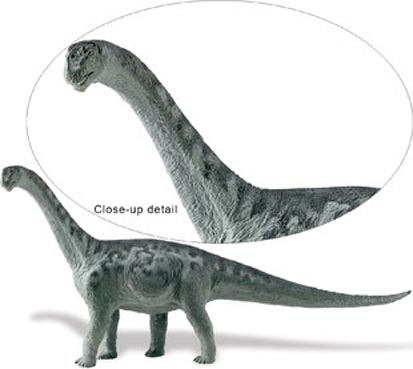Camarasaurids – Evidence for Seasonal Migrations
Camarasaurids – Oxygen Isotopes Preserved in Fossilised Teeth Indicate Migration
The greatest mammal land migration seen today might be the 1.5 million wildebeest (Connochaetus taruinus) or thereabouts, that seasonally migrate from the Masai Mara in Kenya to the Serengeti of Tanzania in search of fresh grazing. However, additional evidence to support the long-held theory that dinosaurs also migrated has been found following an extensive study of sauropod teeth.
The sauropods, were plant-eating dinosaurs (saurischians), with small heads, long necks and long tails. Their massive bodies were supported on immense trunk-like legs. It had been postulated that these animals, some species of which were the largest terrestrial land animals known to science, did migrate in such of food. These enormous creatures would soon deplete an area of vegetation and so they would have to move on in search of more food.
Sauropod Teeth
Now data from a study of camarasaurid teeth (a type of sauropod), suggests that some species may have migrated hundreds of miles in seasonal migrations.
Given their enormous appetites and water needs, their ability to survive in lowland flood plains affected by seasonal dry spells and drought has puzzled scientists, the only explanation offered was that these animals must have migrated to find more suitable feeding areas, when the lowland plains were subjected to the seasonal dry spell.
Now researchers have learned at least one sauropod species made regular journeys between lowland to highland habitats covering several hundred miles.
The evidence is in the teeth of Camarasaurus, a large sauropod which grew to a length of 20 metres and is a relative of the better-known brachiosaurids.
Fossilised Camarasaurus teeth, found in the U.S. states of Wyoming and Utah, contained a chemical record of the animals’ movements during the Late Jurassic period around 150 million years ago.
As different atomic versions of oxygen, or isotopes, occur in the surface water of lowland and highland regions, any isotopes found in the fossilised teeth of these dinosaurs would provide an indication of where these animals travelled to.
These differences remained imprinted in the oxygen from drinking water deposited in the Camarasaurus teeth.
An Illustration of a Typical Camarasaurid Dinosaur
Picture credit: Everything Dinosaur
The model in the image above comes from the Safari Ltd range of prehistoric animal figures.
To view this range including Camarasaurus models (whilst stocks last): Camarasaurus Models and Sauropod Figures (Wild Dinos).
Comparing the oxygen isotopes to those in ancient soil, lake and wetland samples revealed a picture of the dinosaurs’ migration patterns.
The researchers, led by Dr Henry Fricke, from Colorado College, (United States) commented about the migrating dinosaurs in the scientific journal Nature:
“Camarasaurus populations… must have directly occupied high-elevated regions for at least part of the year before returning to the basin where they died.”
Camarasaurus fossils are some of the more common (relatively) sauropod fossils found in the Upper Jurassic rocks of the famous Morrison Formation of the western United States. An analysis of the isotopes of oxygen preserved within the fossilised remains of the teeth of these herbivores provides scientists with an understanding of their seasonal movements.
The team studied the ratio of oxygen isotopes in Camarasaurus teeth. The oxygen comes from surrounding soil, lakes and wetlands and the isotope ratios are specific to a particular area. The isotopes are laid down in the enamel as the tooth grows. The oldest enamel is at the tip and youngest at the base. So, the isotopes recorded in the enamel become a sort of time-line. By comparing oxygen isotope ratios in the tooth enamel with those preserved in the animal’s surroundings, scientists can tell where the animal was living at particular times.
The team found, at seasonal points, the isotope ratios in the Camarasaurus teeth differed from those in its home habitat. Instead, it corresponded to those from highlands nearly two hundred miles away. This evidence suggests that these creatures did indeed migrate.
A spokesperson for Everything Dinosaur noted:
“This new study adds weight to the theory that certain types of dinosaurs migrated just as many mammals and birds do today.”
A herd of huge Camarasaurus dinosaurs walking slowly across the lowland plain to the richer feeding grounds of the upland areas would have been a wonderful sight. However, these plant-eaters probably did not migrate alone. Just as many other plant-eating animals travel with the wildebeest in eastern Africa (zebra, buffalo, antelopes) in search of grazing it is likely that a number of other types of dinosaur migrated with the sauropods to find better feeding areas.
The Everything Dinosaur spokesperson added:
“If large numbers of plant-eaters migrate, then we see the formation of predator trails to, with the meat-eaters adapting their behaviour to cope with this seasonal fluctuation in prey animals. It is likely that these behaviours were also adopted by the predatory dinosaurs in the region, animals such as the fearsome Allosaurus.”
This is not the first time that an analysis of isotopes found in dinosaur teeth has provided scientists with new information about prehistoric animals. In June, we published information on the work carried out by another group of American researchers (California Institute of Technology) who had examined sauropod teeth found in Africa, in a bid to determine whether these animals were warm-blooded.
To read more about this research: American Researchers use Teeth to Find Evidence of Warm-Blooded Dinosaurs.


